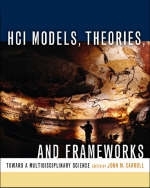
HCI Models, Theories and Frameworks
Morgan Kaufmann Publishers In (Verlag)
978-1-55860-808-5 (ISBN)
- Titel ist leider vergriffen;
keine Neuauflage - Artikel merken
Finally a thorough pedagogical survey of the multidisciplinary science of HCI. Human-Computer Interaction spans many disciplines, from the social and behavioral sciences to information and computer technology. But of all the textbooks on HCI technology and applications, none has adequately addressed HCI's multidisciplinary foundations until now. "HCI Models, Theories, and Frameworks" fills a huge void in the education and training of advanced HCI students. Its authors comprise a veritable house of diamonds internationally known HCI researchers, every one of whom has successfully applied a unique scientific method to solve practical problems. Each chapter focuses on a different scientific analysis or approach, but all in an identical format, especially designed to facilitate comparison of the various models. "HCI Models, Theories, and Frameworks" answers the question raised by the other HCI textbooks: How can HCI theory can support practice in HCI? It traces HCI research from its origins, surveys 14 different successful research approaches in HCI, and presents each approach in a common format to facilitate comparisons.
The contributors are leading researchers in the field of Human-Computer Interaction. It fills a major gap in current literature about the rich scientific foundations of HCI, and provides a thorough pedogological survey of the science of HCI.
John M. Carroll is Professor of Computer Science, Education, and Psychology, and Director of the Center for Human-Computer Interaction, at Virginia Tech. He has written more than 250 technical papers, more than 25 conference plenary addresses, and 12 books. He serves on 10 editorial boards for journals and handbooks, has won the Rigo Career Achievement Award from ACM, received the Silver Core Award from IFIP, and is a member of the CHI Academy.
Acknowledgments 1. Introduction: Toward a Multidisciplinary Science of Human-Computer Interaction by John M. Carroll, Virginia Tech 2. Design as Applied Perception by Colin Ware, University of New Hampshire 3. Motor Behavior Models for Human-Computer Interaction by I. Scott MacKenzie, York University, Toronto, Canada 4. Information Processing and Skilled Behavior by Bonnie E. John, Carnegie Mellon University 5. Notational Systems--The Cognitive Dimensions of Notations Framework by Alan Blackwell and Thomas Green, Cambridge University, Cambridge, England 6. Users' Mental Models: The Very Ideas by Stephen J. Payne, Cardiff University, Wales 7. Exploring and Finding Information by Peter Pirolli, Palo Alto Research Center 8. Distributed Cognition by Mark Perry, Brunel University, London, England 9. Cognitive Work Analysis by Penelope M. Sanderson, University of Queensland, Australia 10. Common Ground in Electronically Mediated Communication: Clark's Theory of Language Use by Andrew Monk, University of York, England 11. Activity Theory by Olav W. Bertelsen and Susanne Bodker, University of Aarhus, Denmark 12. Applying Social Psychological Theory to the Problems of Group Work by Robert E. Kraut, Carnegie Mellon University 13. Studies of Work in Human-Computer Interaction by Graham Button, Xerox Research Centre Europe, Grenoble, France 14. Upside-Down Vs and AlgorithmsComputational Formalisms and Theory by Alan Dix, Lancaster University, England 15. Design Rationale as Theory by John M. Carroll and Mary Beth Rosson, Virginia Tech
| Erscheint lt. Verlag | 21.5.2003 |
|---|---|
| Reihe/Serie | Interactive Technologies |
| Verlagsort | San Francisco |
| Sprache | englisch |
| Maße | 187 x 235 mm |
| Gewicht | 1000 g |
| Themenwelt | Informatik ► Software Entwicklung ► User Interfaces (HCI) |
| ISBN-10 | 1-55860-808-7 / 1558608087 |
| ISBN-13 | 978-1-55860-808-5 / 9781558608085 |
| Zustand | Neuware |
| Haben Sie eine Frage zum Produkt? |
aus dem Bereich


